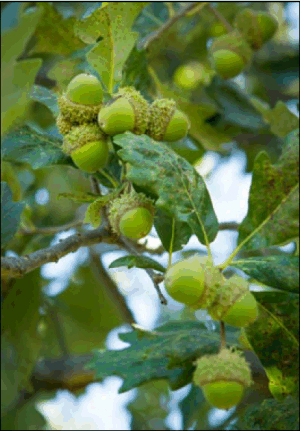Green Horizons
Volume 18, Number 3Fall 2014
The Bucks Unlimited Oak Way
By Scott Brundage, Gene Garrett, Mark Coggeshall, Kim Young
 |
Photo by Kyle Spradley |
The Buck’s Unlimited Oaks were developed at the Horticulture and Agroforestry Research Center in New Franklin, Mo. They produce heavy annual swamp white oak acorn crops by age six. |
Gene Garrett, retired Director of the Center for Agroforestry at the University of Missouri, talks of seeing newly planted seedbeds of swamp white oak acorns, dug out and eaten by deer the first night after planting. John Burk,wildlife biologist at the National Wild Turkey Federation,and an avid Missouri deer hunter, said that many times hehas seen deer walk through a carpet of white oak acornswithout eating them to get to swamp white oak acorns nearby. The late Bill Yoder, former nursery manager at the Mo. Department of Conservation's State Tree Nursery in Licking, Mo., once stated that if a "mesh cover" was not immediately placed over newly planted swamp whiteoak acorns, the majority would be dug up and eaten by deer, while acorns of other species went untouched. Many stories are told about deer seemingly preferring swamp white oak acorns over acorns from other species.
Since 1998, UMCA has studied swamp white oak acorn production. What began as a study of eight carefully selected half-sib (same mother, different father trees) swamp whiteoak trees has led to a grafted acorn production orchard,consisting of multiple replications of the four best acorn producers from the original eight trees. The four have shown excellent growth rates along with early and consistent annual acorn production. The trees release their acorns over several weeks, from late September into late October and early November, which is of special importance to bow hunters. These characteristics have also been observed in the seedlings produced from the grafted orchard trees.
 |
Photo by Kyle Spradley |
The Bucks Unlimited Oak trees are planted and growing. |
From these research findings, UMCA announces the introduction of the new "Bucks Unlimited OakT." These are premium quality, fast growing swamp white oak seedlings that produce acorns at a very young age. Studies have demonstrated that limited flowering and fruiting can begin on these seedling trees by age 4. Of even greatersignificance, 75 percent of the seedling trees produce acorns by age 6. Not only is this early and heavy production highly desirable for deer, it is equally valuable for all wildlife species that depend upon acorns as a food source. The Bucks Unlimited Oak is truly the "performance oak for wildlife."
The University of Missouri has entered into a legal agreement with The Forrest Keeling Nursery in Elsberry, Mo. to grow and market The Bucks Unlimited Oak. The trees will be grown using Forrest Keeling's patented Root Production Method (RPM), which research by UMCA shows significant increases in growth and early fruiting of outplanted stock over seedlings produced using more conventional methods. A percentage of the profits earned on sales will be paid to the Center for Agroforestry to support future oak research.